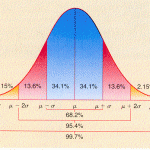September 22nd, 2008 by Frank LaBanca, Ed.D.
 I have been struggling with trying to describe my last statistics class (central tendency, normal distribution) in a holistic way. The content was certainly more demanding than previous classes, yet I felt the students stayed with me well. I gave an assignment to allow the students to process the information and see if they really understood it. Although the assignment barely took up half a page, I felt that it would probably take a good chunk of time to complete.
I have been struggling with trying to describe my last statistics class (central tendency, normal distribution) in a holistic way. The content was certainly more demanding than previous classes, yet I felt the students stayed with me well. I gave an assignment to allow the students to process the information and see if they really understood it. Although the assignment barely took up half a page, I felt that it would probably take a good chunk of time to complete.
I have received many comments from students quantifying the time they spent on the assignment. Ironically the time frame “4 hours” seems to be quite common. I think this is reasonable as the rule of thumb suggests that for every hour you spend in class, you are expected to spend at least two hours working on the course materials. So four hours seems about right to me. I hope that it is not perceived as too much, as I make no qualms that statistics is a very demanding and rigorous course. I feel the experience of the assignment necessitates an extended period of time where students work through the problems and come to a true understanding of the concepts.
That being said, I did not give explicit instructions for all computer tasks necessary to complete the assignment. There was some sorting and sifting – in essence – some inductive reasoning – that had to be accomplished for successful completion of the assignment.
 When I think of inquiry as an approach to learning (which is certainly the approach I hope to use when I teach), I realize that there is no one way to solve a problem. However, students often look for the step-by-step, one-size-fits-all method to approach problems. While there are some straight-forward techniques and patterns in statistical analysis, I think it is the willingness of the individual to approach the problem solving from a creative avenue, that ultimately makes them successful.
When I think of inquiry as an approach to learning (which is certainly the approach I hope to use when I teach), I realize that there is no one way to solve a problem. However, students often look for the step-by-step, one-size-fits-all method to approach problems. While there are some straight-forward techniques and patterns in statistical analysis, I think it is the willingness of the individual to approach the problem solving from a creative avenue, that ultimately makes them successful.
High-achieving students not only want to learn concepts well, they sometimes also want to complete assignments the way they perceive that the teacher wants it. This has always been an area of contention for some of my students, because I want them to complete their work so they demonstrate meaningful understanding, whether it’s in the format I want or not. You see, I do not perceive my way as the only way. I love to look at solutions that I had not previously conceived. To me, it’s exciting and interesting. To some, it can be very disconcerting. I do not buy into the concept of the right answer. I more readily appreciate the best answer. I don’t define best; that is the ultimate goal for the student.
I recently received an email from a student asking two questions to help decide how to represent data. This data was generated and/or collected by the student, and probably has some personal meaning to the student. The student certainly has a far better understanding of the sample and of the data set that demonstrates some characteristics of the sample than I do. So, although I may have a better understanding of types of analysis, I would venture that the student has a much better understanding of the meaning and relevance of the data.
Thanks for your great effort to learn the stats and SPSS.
Both of your questions are interesting to me as a teacher because I always try to empower my student to make the decision on what is important to show. You have great judgment since you know the data best, so try to select information which “tells the best story.” I guess your questions answers are “it depends,” because there are really no right or wrong answers. The decisions you make for data display will be appropriate in either scenario you present. I’ve personally been struggling with what to write about on my blog this week, but I think your question helps me focus my ideas. Thank you for that.
So that’s ultimately the challenge of an inquiry approach – to empower students to make the choices to best answer their questions in a meaningful way for them. I think this is sometimes frustrating, but in the end, I think this is the way the best learning takes place.
Now don’t come to lynch me on Wednesday with a pitchfork!